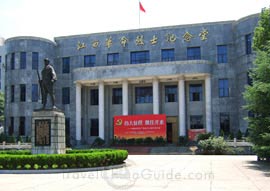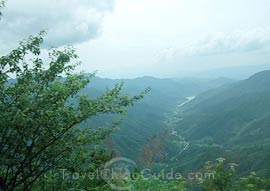Jiangxi Travel Guide
Jiangxi Facts
Chinese Name: 江西 (jiāng xī)
Abbreviation: Gan
Population: 46,661,000
Area: 166,900 square kilometers (64,440 square miles)
Location: in the east of China
Administrative Division: 11 cities (Nanchang, Jingdezhen, Pingxiang, Jiujiang, Xinyu, Yingtan, Ganzhou, Ji’an, Yichun, Fuzhou, Shangrao)
GDP (2019): CNY 2,475.75 billion (USD 358.86 billion)
Jiangxi Province with Nanchang as the capital is located in the south bank of the middle and lower reaches of the Yangtze River in the central part of southeast China. It borders Zhejiang and Fujian to the east, Anhui and Hubei to the north, Hunan to the west and Guangdong to the south. Ganjiang River, a tributary of the Yangtze River, runs through the whole territory from south to north and flows into Poyang Lake, the largest fresh water lake in China. Every year, numerous migratory birds overwinter in this place.
Jiangxi is rich in mineral resources, especially the nonferrous, rare earth and precious metals. One of the super large copper industrial bases in Asia is just situated here. You can visit Jingdezhen, a leading porcelain-manufacturing center, famous for producing fine porcelain which is "white as jade, bright as a mirror, thin as paper and sound as chime". What’s more, no visitors cannot be affected by the towering and precipitous mountains like Mt. Lushan, beautiful countryside views in Wuyuan, well-known Pavilion of Prince Teng, time-honored Bailudong Academy and Donglin Temple, the birthplace of Pure Land Buddhism.
Cities in Jiangxi
When to Go
 The best time to visit Jiangxi is spring and autumn. Jiangxi has a warm and humid climate with cold springs and winters, hot summers and dry autumns thus accounting for its four distinct seasons. Annual rainfall averages 1400-1800 millimeters and the average temperature of the province is 3-9
The best time to visit Jiangxi is spring and autumn. Jiangxi has a warm and humid climate with cold springs and winters, hot summers and dry autumns thus accounting for its four distinct seasons. Annual rainfall averages 1400-1800 millimeters and the average temperature of the province is 3-9![]() C in January and 27-31
C in January and 27-31![]() C in July.
C in July.
Where to Go
Jiangxi province is a showcase for natural beauty. Visitors will find it hard to leave its beautiful mountains, lakes and rivers. Particularly attractive is Poyang Lake, which is not only the biggest fresh water lake in China, but also the largest winter habitat for white cranes. When winter approaches, about 2,800 white cranes will migrate to Poyang Lake to spend their winter. What a spectacular sight! On the east side of this lake is Mt. Lushan, a wonderful summer resort with its lush mountains, enveloping clouds and mists, rapid streams and numerous deep pools and waterfalls. Mysterious and enchanting sceneries nestle in its secluded valleys and deep ravines. Sudongpo, a well-known poet of the Song Dynasty (960-1279), in honor of the 'Cloud Sea' of Mt. Lushan for its ever - changing mist, wrote, 'The failure to get a real perspective of the mountain only results in the fact that you are right in the midst of it'. Another mountain - Jinggangshan enjoys a dual reputation. It is more widely known as the cradle of the Chinese revolution rather than for its natural beauty, which is, in fact, comparable to the more famous Lu Shan.
History
 The historical sites of Jiangxi Province also attract guests from all corners of the world. Nanchang is its capital. Pavilion of Prince Teng is located just west of Nanchang and is one of three famous pavilions south of the Yangtze River. This pavilion gained its reputation to a great extent because of a well-known poem called 'Preface to Tengwang Pavilion' by Wangbo, a reputable poet of the Tang Dynasty. Donglin Monastery is located at the foot of Lushan. It was built in 386 for the monk Hui Yuan (334-416), founder of the Pure Land sect of Buddhism. Hui Yuan spent many years translating Buddhist scriptures in this temple.
The historical sites of Jiangxi Province also attract guests from all corners of the world. Nanchang is its capital. Pavilion of Prince Teng is located just west of Nanchang and is one of three famous pavilions south of the Yangtze River. This pavilion gained its reputation to a great extent because of a well-known poem called 'Preface to Tengwang Pavilion' by Wangbo, a reputable poet of the Tang Dynasty. Donglin Monastery is located at the foot of Lushan. It was built in 386 for the monk Hui Yuan (334-416), founder of the Pure Land sect of Buddhism. Hui Yuan spent many years translating Buddhist scriptures in this temple.
Local Highlights
The highlight of Jiangxi travel should be Jingdezhen, which is known as the 'Capital of Porcelain' in China. Ceramics were produced here as early as 1,800 years ago in the Eastern Han Dynasty. Today, Jingdezhen remains a national center for porcelain production. While in this ancient town, visitors can visit many pottery factories and ancient kiln sites. In addition, Jiangxi is one of the ancient tea-producing areas. The Black Tea produced in Ningzhou City and the Green Tea produced in Wuyuan City are well-known throughout the country.